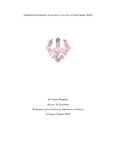| dc.rights.license | In Copyright | en_US |
| dc.creator | Waggoner, Tanner J. | |
| dc.date.accessioned | 2016-07-27T14:43:01Z | |
| dc.date.available | 2016-07-27T14:43:01Z | |
| dc.date.created | 2016 | |
| dc.identifier | WLURG38_Waggoner_GEOL_2016 | |
| dc.identifier.uri | http://hdl.handle.net/11021/33560 | |
| dc.description | Thesis; [FULL-TEXT FREELY AVAILABLE ONLINE] | en_US |
| dc.description | Tanner J. Waggoner is a member of the Class of 2016 of Washington and Lee University. | en_US |
| dc.description.abstract | Acropora cervicornis (staghorn coral) is an important framework-building scleractinian coral that dominated many Caribbean reefs throughout the Pleistocene and Holocene. Acropora spp. suffered collapse throughout the Caribbean since the 1980s as a result of white band disease and other stressors. Despite widespread decline, large populations of Acropora spp. are currently thriving at Coral Gardens Reef, Belize, south of Ambergris Caye where live coral cover is as high as 50% in some areas. This project aims to discern whether these populations were established after the Caribbean acroporid collapse or whether they are remnant populations from before the 1980s. To determine the timing of Acropora spp. dominance at Coral Gardens, pristine aragonite material was sampled from dead coral skeletons excavated from stratigraphic "pits' in the coral death assemblage at three underwater sites. Of the three sites, Pits A, B, and C extended approximately 1 meter, 1.2 meters and 2 meters beneath the reef surface, respectively. Six aragonite samples were extracted from Pit A, 17 from Pit B, and 16 from Pit C, and aged using conventional radiocarbon dating techniques. Carbon isotope ratios from radiocarbon analysis for samples from the dead assemblage indicate that A. cervicornis growth was initiated prior to the well-documented spike in atmospheric radiocarbon caused by nuclear weapons testing (late 1950s) and persisted throughout the mid-1960s. However, due to the lack of high resolution post-bomb radiocarbon calibration data for marine reservoir effects near Belize, additional dating techniques were needed to resolve the age of the more recent A. cervicornis corals. We used high-precision U-Th dating recently developed by Clark et al. (2014a) to better constrain the chronological persistence of A. cervicornis at Coral Gardens. 230Th age data suggest that some of the A. cervicornis populations in Coral Gardens survived the wide-spread 1980s Caribbean acroporid coral collapse and that corals from beneath the living A. cervicornis canopy are synchronous with those taken from the surface of Pit C. Results suggest some degree of continuity in reef growth at this site amidst greater Caribbean collapse of Acropora spp. | en_US |
| dc.format.extent | 44 pages | en_US |
| dc.language.iso | en_US | en_US |
| dc.rights | This material is made available for use in research, teaching, and private study, pursuant to U.S. Copyright law. The user assumes full responsibility for any use of the materials, including but not limited to, infringement of copyright and publication rights of reproduced materials. Any materials used should be fully credited with the source. | en_US |
| dc.rights.uri | http://rightsstatements.org/vocab/InC/1.0/ | en_US |
| dc.subject.other | Washington and Lee University -- Honors in Geology | en_US |
| dc.title | Chronological Persistence of Acropora cervicornis at Coral Gardens, Belize (thesis) | en_US |
| dc.type | Text | en_US |
| dcterms.isPartOf | RG38 - Student Papers | |
| dc.rights.holder | Waggoner, Tanner J. | |
| dc.subject.fast | Acropora cervicornis | en_US |
| dc.subject.fast | Resilience (Ecology) | en_US |
| dc.subject.fast | Corals -- Ecology | en_US |
| dc.subject.fast | Belize -- Ambergris Cay | en_US |
| local.department | Geology | en_US |
| local.scholarshiptype | Honors Thesis | en_US |
